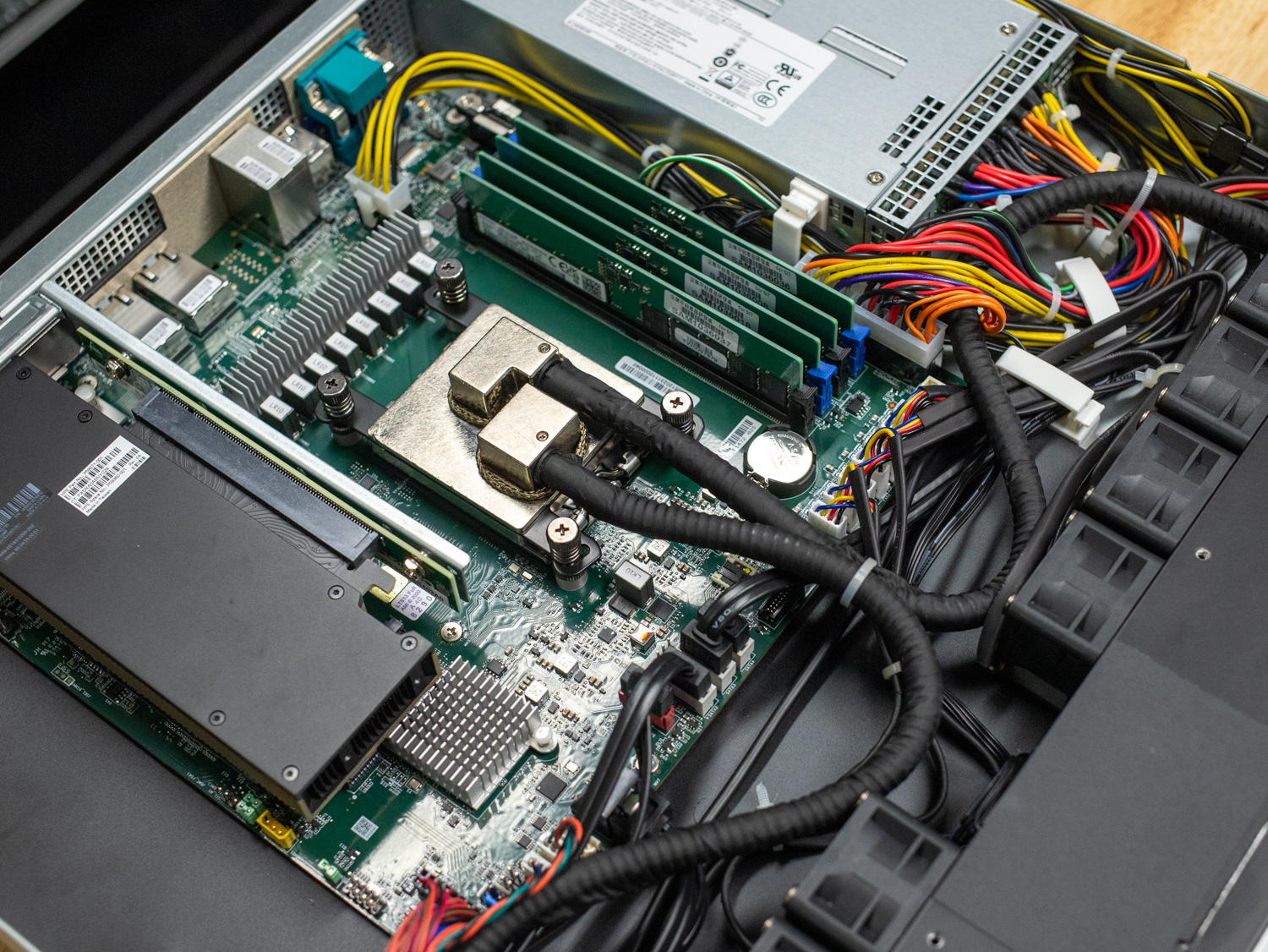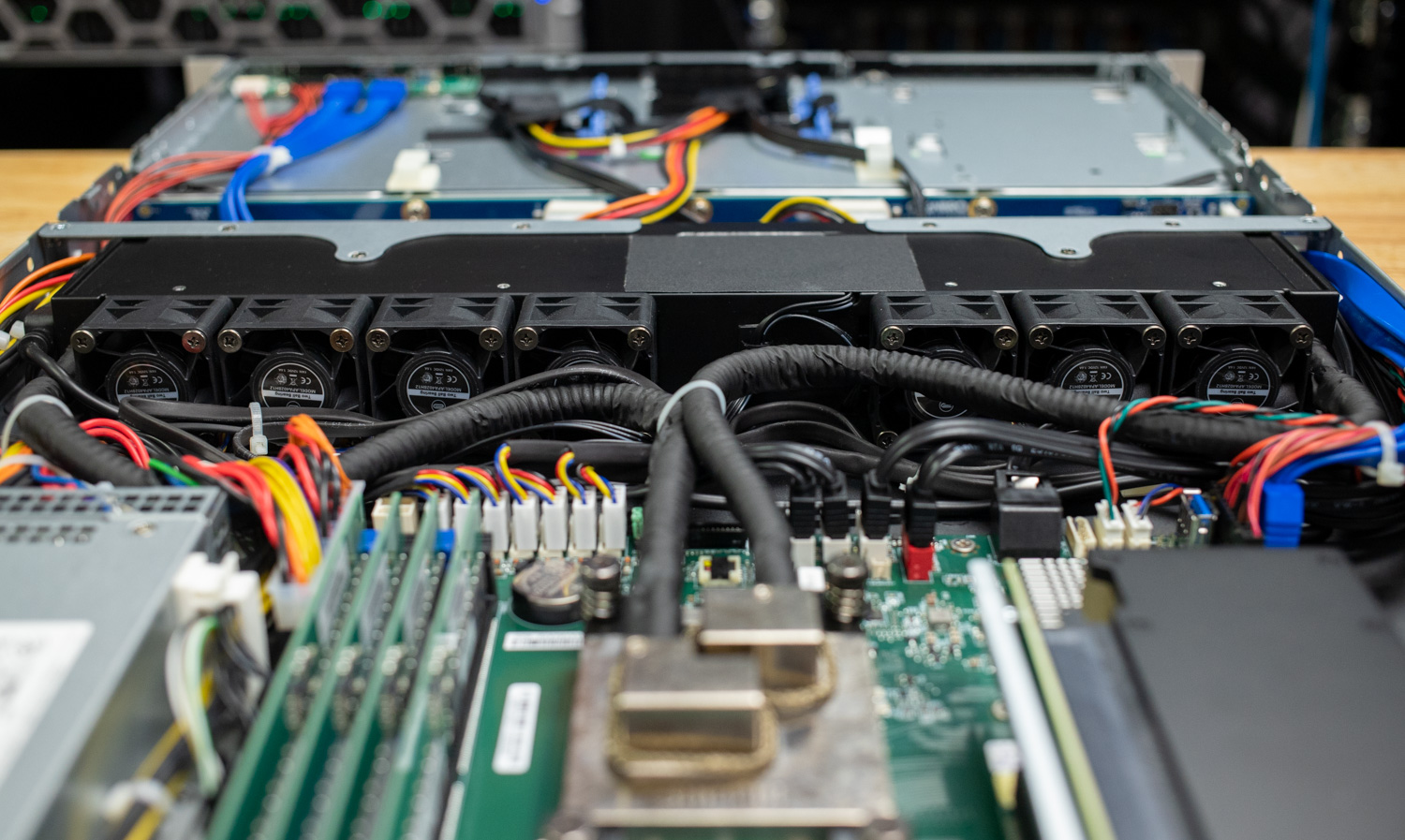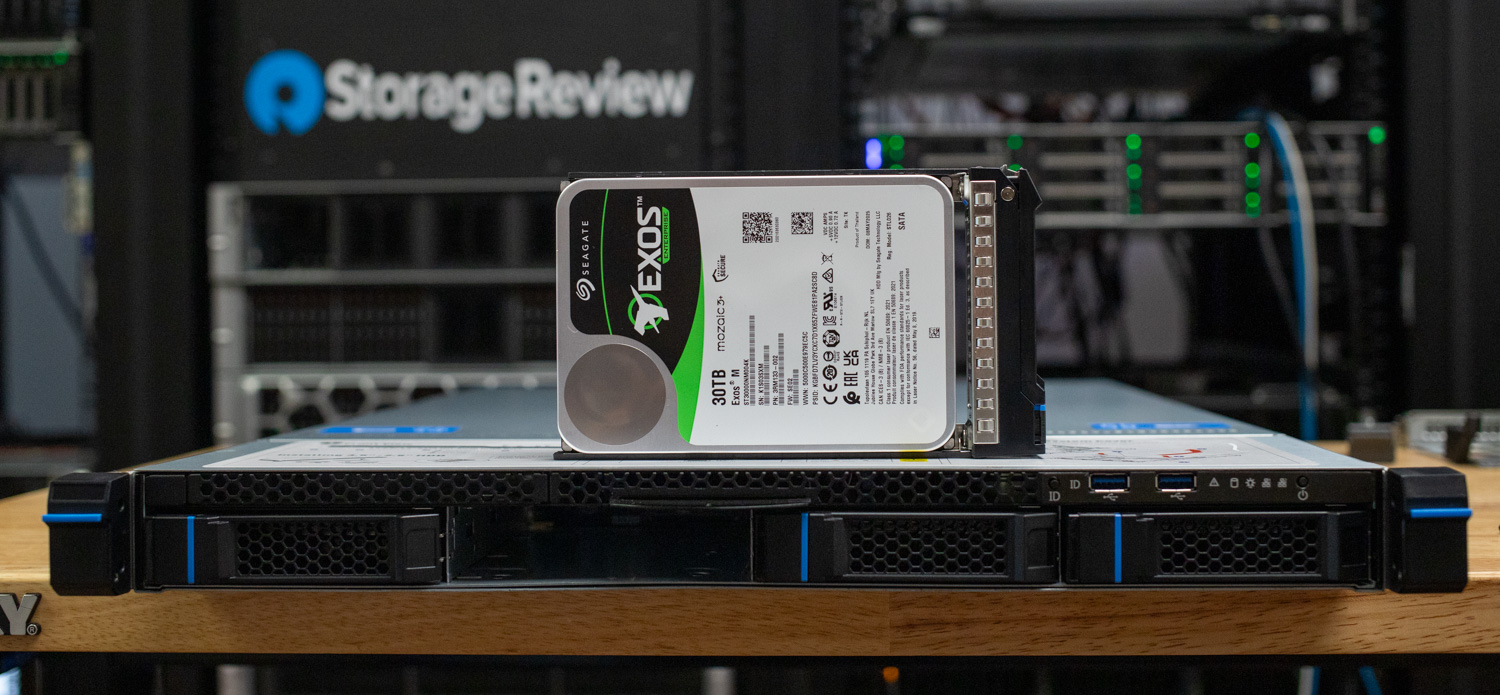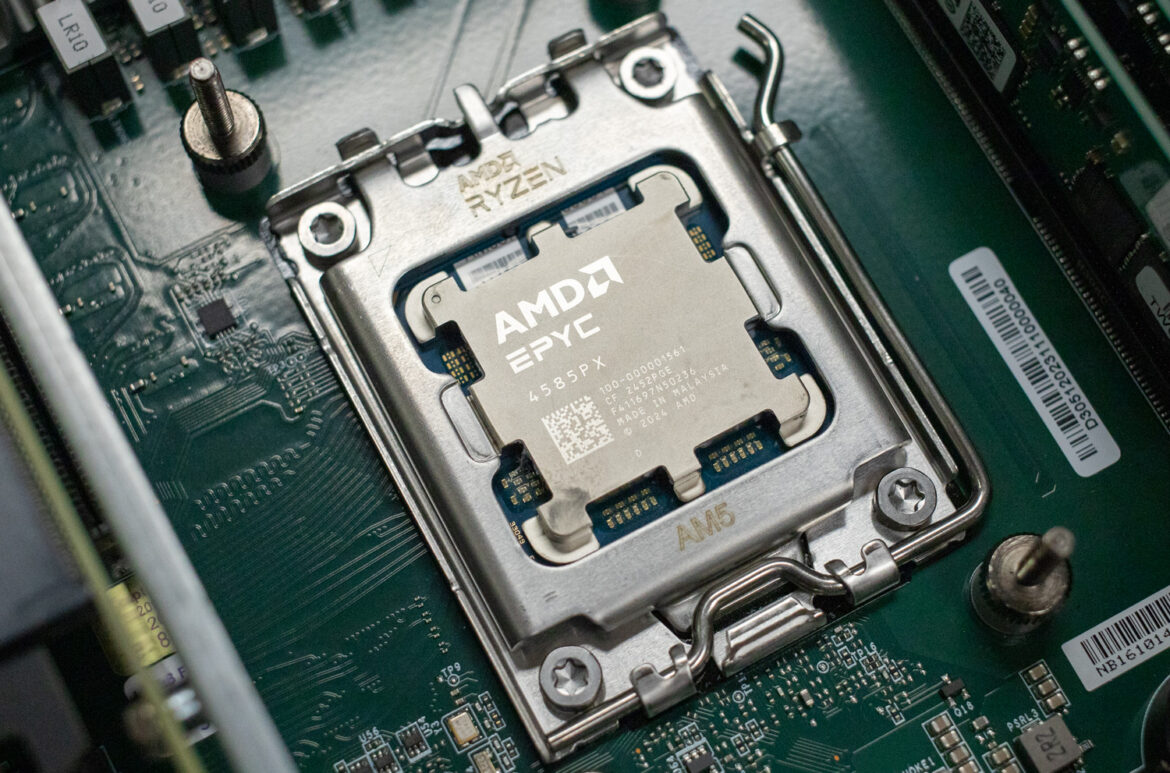EPYC 4005 review: Zen 5 on AM5 with DDR5-5600, AVX-512, and a 65 W 16-core, bridging Ryzen and big EPYC for service providers.
AMD’s EPYC 4005 family brings Zen 5 to AM5 with a clear operational goal. Keep the platform consistent for system builders and hosters, then tighten the pieces that matter for day-to-day use. The result is a server-first take on AM5 that favors predictable rollouts, stable firmware, and an OS matrix built for scale.

In AMD’s lineup, EPYC 4005 sits between Ryzen on AM5 and the higher-end EPYC platforms on SP5 and SP6. Ryzen can anchor light server roles, but it does not carry the validation depth, lifecycle, or feature set that data center operators expect. The big sockets deliver more cores, memory channels, and lanes, along with a much higher cost. EPYC 4005 bridges that gap. You keep AM5 economics and simplicity while getting enterprise framing that fits common licensing and power envelopes.
The SKU stack reflects that intent. Coverage stretches in both directions so buyers can standardize on a modest power budget or step up to a cache-heavy top bin for latency-sensitive services, all without changing chassis or I/O plans.
AMD EPYC 4004 vs 4005: The Practical Upgrades
EPYC 4005 is a straightforward generational lift over 4004 that keeps the AM5 story intact while enhancing the platform. With 4005, you get Zen 5 cores, a bump in RAM performance to DDR5-5600, and the same up to 28 lanes of PCIe Gen5. AMD also adds AVX-512 with a full 512-bit data path, which gives this class of single-socket servers a little more headroom for vector-heavy work without changing boards or chassis.
At the top of the stack, the like-for-like story is simple. The EPYC 4565P in 4005 is a 16-core part with 64MB of L3, a 170 W TDP, and clocks up to 5.7 GHz. Its 4004 counterpart, EPYC 4564P, is also a 16-core with 64MB of L3 and a 170 W TDP, with the same 5.7 GHz max boost. That means generational gains come from the core and platform updates rather than a significant leap in specifications.
If you care about cache-bound work, both families offer a 3D V-Cache option, but 4005 moves the top bin to EPYC 4585PX at 170W and 128MB L3, while 4004 tops out with EPYC 4584PX at 120W and the same 128MB. Base clocks also tick up slightly on the 4585PX.
The most significant practical addition in 4005 is a 16-core, 65W SKU. EPYC 4545P gives hosted bare metal and SMB servers a way to standardize on 16 cores for Windows licensing while staying inside tighter power and cooling envelopes. That option did not exist in 4004, where 16-core meant 170W on the standard die or a 120W V-Cache part with lower base clocks.
As noted, memory support is improved somewhat. The 4004 validated two channels of DDR5 at up to 5200MT/s. 4005 pushes that to 5600MT/s and raises maximum supported capacity at the platform level to 192GB from 128GB, which helps mixed virtualized loads and small database instances.
EPYC 4004 vs 4005 CPU Lineup
| AMD EPYC 4004 Series Models | Arch. | Cores/Threads | L3 Cache (MB) | TDP (W) | Base Clock (GHz) | Boost Clock (GHz) | Price (1KU, USD) |
|---|---|---|---|---|---|---|---|
| EPYC 4124P | Zen 4 | 4 / 8 | 16 | 65W | 3.8 | 5.1 | $149 |
| EPYC 4244P | Zen 4 | 6 / 12 | 32 | 65W | 3.8 | 5.1 | $229 |
| EPYC 4344P | Zen 4 | 8 / 16 | 32 | 65W | 3.8 | 5.3 | $329 |
| EPYC 4364P | Zen 4 | 8 / 16 | 32 | 105W | 4.5 | 5.4 | $399 |
| EPYC 4464P | Zen 4 | 12 / 24 | 64 | 65W | 3.7 | 5.4 | $429 |
| EPYC 4484PX | Zen 4 | 12 / 24 | 128 | 120W | 4.4 | 5.6 | $599 |
| EPYC 4564P | Zen 4 | 16 / 32 | 64 | 170W | 4.5 | 5.7 | $699 |
| EPYC 4584PX | Zen 4 | 16 / 32 | 128 | 120W | 4.2 | 5.7 | $699 |
| AMD EPYC 4005 Series Models | |||||||
| EPYC 4245P | Zen 5 | 6 / 12 | 32 | 65W | 3.9 | 5.4 | $239 |
| EPYC 4345P | Zen 5 | 8 / 16 | 32 | 65W | 3.8 | 5.5 | $329 |
| EPYC 4465P | Zen 5 | 12 / 24 | 64 | 65W | 3.4 | 5.4 | $399 |
| EPYC 4545P | Zen 5 | 16 / 32 | 64 | 65W | 3.0 | 5.4 | $549 |
| EPYC 4565P | Zen 5 | 16 / 32 | 64 | 170W | 4.3 | 5.7 | $589 |
| EPYC 4585PX | Zen 5 | 16 / 32 | 128 | 170W | 4.3 | 5.7 | $699 |
Test Platform: MSI S1102-02 with Liquid Cooling
For this review, our platform is MSI’s S1102-02, a 1U AM5 barebone that lines up neatly with the EPYC 4005 target market. It supports up to 170W AM5 processors and ours ships with an optional factory closed-loop liquid cooler, which is unusual in this class and a good fit for the top-bin 4005 SKUs. If nothing else, the loop should help lower the need for the fans to spin as much or as loudly. Speaking of fans, the chassis pairs that loop with seven 40mm system fans, a 1+1 600 W Platinum PSU, and a full management stack via an AST2600 BMC with IPMI and Redfish.

Networking comes by way of dual 10GbE RJ45 ports on Intel’s X710. Storage is straightforward with four front hot-swap SATA bays, two internal 2.5-inch SATA bays, and two M.2 2280/22110 NVMe slots. Expansion includes a Gen5 x16 slot for FHHL cards and a shared Gen4 x4 path that can be routed either to a secondary PCIe slot or to one of the M.2 sockets. Memory is four DDR5 UDIMM slots with ECC support, validated up to 5600 MT/s at 1DPC and 48 GB per DIMM for a 192 GB platform ceiling. Physical depth is 26 inches, which keeps deployment options flexible in short racks.

Full MSI S1102-02 Specs
| Specification | Details |
| Form Factor | 1U |
| Dimensions | 438.5mm(17.26″) Wx 43.5mm(1.71″)H x 660mm(26″)D |
| Processor | Single AMD Ryzen™ 7000/9000 Series and EPYC™ 4004/4005 Series Processor, up to TDP 170W |
| Socket | (1) AMD Socket AM5 |
| Chipset | AMD B650 |
| Memory | (4) DDR5 DIMM slots, 2DPC, ECC/non-ECC UDIMM – Max. Frequency 5600MT/s(1DPC) and 3600MT/s(2DPC) – Max. Capacity per DIMM: 48GB |
| Drive Bays | (4) Hot-swap 3.5”/2.5″ drive bays support SATA 3.0 |
| Internal Storage | (2) M.2 2280/22110 PCIe4.0 x4 ports (2) Internal 2.5″ drive bays support SATA 2.0 |
| Expansion Slots | (1) PCIe 4.0 x16 slot from CPU supports FHHL PCIe card |
| Networking | (2) 10GBase-T Ethernet Ports (Intel® X710AT2) *JLAN1,2 supports NCSI |
| RAID | N/A |
| Front I/O | (4) Hot-swap 3.5” drive bays (2) USB3.2 Gen1 Type-A Ports (1) System Power Button (1) UID Button (1) UID LED (5) Status LEDs: Power/Fault/HDD/(2)LAN |
| Rear I/O | (2) 10GBase-T Ethernet Ports (1) 1000Base-T Dedicated Server Management Port (4) USB3.2 Gen1 Type-A Ports (1) VGA D-Sub Port (1) COM DB9 Port (1) UID LED Button |
| TPM | (1) TPM header with SPI interface |
| Security | TPM 2.0 |
| Server Management | (1) 1000Base-T Dedicated Server Management Port (Realtek RTL8211FD-CG) ASPEED AST2600 with AMI MegaRAC based firmware supporting IPMI 2.0 and DMTF Redfish API |
| Environment | System Operating Temperature : 0°C ~ 35°C Non-operating Temperature : -20°C ~ 70°C Non-operating Relative Humidity : 5% ~ 85% (non-condensing) |
| Power Supply | (1+1) 450W Redundant PSU 80+ Platinum |
| Cooling | (1) Closed loop liquid cooling module for max. 170W CPU (7) 4028 system FANs |
| Certification | CE, FCC (Class A) |
| Package Contents | (1) 1U Barebone S1102-02 (1) Quick guide (1) Slide rail Kit (1) Closed loop liquid cooling module(assembled inside chassis) (4) Power cables |
| Parts List | (1) Quick guide: G52-S3362X2-Q13 (1) Slide rail Kit: E21-S336020-C27 (1) Closed loop liquid cooling module: E34-F000091-AQ0 (4) Power cables: (2)K33-3001002-I45 for NA, (2)K33-3001005-I45 for EU |
| Optional Parts | TPM2.0 module: TPM20-IR C13 power cord 250V/10A(CN): K33-3001029-I45 C13 power cord 125V/13A(JP): K33-3001346-I45 |
AMD EPYC 4005 Performance
In this review, we will compare the 16-core AMD EPYC 4564P with 64MB of cache from the 4004 generation to the 16-core AMD EPYC 4585PX with 128MB of cache from the 4005 generation. Tests were run in the MSI S1102-2 Server as previously mentioned. Here are the components in the MSI S1102-02 test server:
- AMD EPYC 4585PX or AMD EPYC 4564P
- NVIDIA L4 GPU
- 4 x Seagate Exos M 30TB HDDs
- Solidigm P44 Pro M.2 Boot SSD
- 4 x Samsung 16GB DDR5-4800 ECC UDIMM

Y-Cruncher
y-cruncher is a multithreaded, scalable program that can compute Pi and other mathematical constants to trillions of digits. Since its launch in 2009, it has become a popular benchmarking and stress-testing application for overclockers and hardware enthusiasts.
Across the standard y-cruncher runs (1B–10B), the EPYC 4585PX consistently finishes faster than the EPYC 4564P, trimming compute time by 4.5%–10.2%. For example, in the 1-billion-digit test, it posts 18.802s versus 20.933s for the 4564P.
The BBP test shows far larger gains of up to 40% faster, highlighting how sensitive these workloads are to memory latency and L3 capacity. The 1-billion BBP case makes this obvious: 0.387s (4585PX) versus 0.630s (4564P), a 38.6% reduction. Similar advantages hold at higher BBP sizes.
This pattern aligns with the 4585PX’s larger L3 cache (128 MB vs. 64 MB on the 4564P) and architectural improvements
| y-cruncher Total Computation Time (Lower is Better) | AMD EPYC 4585PX 16-Core | AMD EPYC 4564P 16-Core |
| 1 Billion | 18.802 seconds | 20.933 seconds |
| 2.5 Billion | 54.085 seconds | 58.108 seconds |
| 5 Billion | 121.711 seconds | 128.428 seconds |
| 10 Billion | 269.096 seconds | 281.677 seconds |
| 1 Billion BBP | 0.387 seconds | 0.630 seconds |
| 10 Billion BBP | 4.450 seconds | 7.367 seconds |
| 100 Billion BBP | 50.311 seconds | 84.051 seconds |
Blender 4.0
Blender 4.0 is an open-source 3D modeling application. This benchmark was run using the Blender Benchmark CLI utility. The score is measured in samples per minute, with higher values being better.
While both processors performed well for their class, the EPYC 4585PX’s increased cache helps push it a bit faster. For example, the 4585PX in the Monster test achieved 351.90 samples per minute, whereas the 4564P scored 306.57 samples per minute. Not straying far from the same pattern in Junkshop, scores were 226.59 on the 4585PX and 195.26 on the 4564P. Similarly, again on Classroom, with 171.87 and 150.27, respectively.
| Blender 4.0 CPU Samples Per Minute (Higher is Better) | AMD EPYC 4585PX 16-Core | AMD EPYC 4564P 16-Core |
| Monster | 351.90 | 306.57 |
| Junkshop | 226.59 | 195.26 |
| Classroom | 171.87 | 150.27 |
Phoronix Benchmarks
We used the Phoronix Test Suite to automate installs, run workloads, and collect results across five staples: STREAM, 7-Zip, Linux kernel build, Apache HTTP server, and OpenSSL. Below, the EPYC 4585PX is compared directly to the prior-gen EPYC 4564P (both 16-core).
STREAM memory bandwidth: 4585PX trails slightly at 38,472 MB/s vs 40,106.9 MB/s (−4.1%, −1,634.9 MB/s). STREAM is highly sensitive to memory clocks/topology and compiler choices; this points to a small bandwidth edge for the 4564P in our config.
7-Zip (compress+decompress): 4585PX delivers 162,951 MIPS vs. 176,484 MIPS (−7.7%, −13,533 MIPS). 7-Zip leans on integer throughput and cache/memory behavior; here the 4564P is modestly ahead.
Linux kernel compile (allmodconfig): 4585PX completes in 621.967 s vs 747.610 s (-125.643 s, 16.8% faster). Lower time reflects better parallel build throughput from architectural improvements.
Apache requests/sec: 4585PX serves 181,764.45 R/s vs 132,744.77 R/s (+36.9%, +49,019.68 R/s), indicating a sizable advantage in HTTP throughput.
OpenSSL verify: 4585PX hits 400,939,420,057 verify/s vs 224,487,686,510 verify/s (+78.6%, +176.45B verify/s). Crypto workloads benefit from the 4585PX’s architectural gains and larger L3.
Overall: the 4585PX posts substantial leads in build, web, and crypto tests (17-79% gains), while the 4564P edges out on raw memory bandwidth and 7-Zip in our setup.
| Phoronix Benchmarks | AMD EPYC 4585PX 16-Core | AMD EPYC 4564P 16-Core |
| Stream | 38,472.0 MB/s | 40,106.9 MB/s |
| 7-ZIP | 162,951 MIP/s | 176,484 MIP/s |
| Kernel Compile (allmod) | 621.967 Seconds | 747.610 Seconds |
| Apache (requests per second) | 181,764.45 R/s | 132,744.77 R/s |
| OpenSSL | 400,939,420,057 Verify/s | 224,487,686,510 Verify/s |
HDD FIO Performance
The MSI S1102-02 server supports four 3.5″ HDDs in the front, giving the server some storage capacity options for those that need it. While the fastest storage would be through the onboard PCIe 4.0 M.2 slots, we can fit up to 30TB HDDs into the front of this system. Leveraging the Seagate Exos M 30TB SATA HDDs, we measured sequential and random performance using FIO. We measured peak sequential bandwidth of 1.3GB/s read and 1.1GB/s write, with 4K random IOPS measuring 1,720 IOPS read and 1,990 IOPS write. These were figures tested as JBOD, so RAID will play a role in final performance.
| Workload | Highest Bandwidth | Highest IOPS | Lowest Latency |
|---|---|---|---|
| Random Write (4K) | 7.8 MB/s | 1,990 | 2.106 ms |
| Random Read (4K) | 6.7 MB/s | 1,720 | 6.861 ms |
| Sequential Write (128K) | 1,102.5 MB/s | 8,820 | 0.486 ms |
| Sequential Read (128K) | 1,322.3 MB/s | 10,578 | 0.459 ms |
Conclusion
EPYC 4005 does what it set out to do. It keeps AM5 simple for system builders and hosters, then adds useful headroom with Zen 5, validated DDR5-5600, AVX-512, and broader SKU coverage. The family slots cleanly between Ryzen on AM5 and the larger SP5 and SP6 platforms, giving service providers an enterprise solution without the cost of the big sockets. The SKU map covers common deployment models. The EPYC 4545P brings a 16-core at 65W for dense hosting and clean Windows Server licensing. The EPYC 4565P remains the standard 170W workhorse, whereas the EPYC 4585PX adds 3D V-Cache for latency-sensitive services that lean on a larger last-level cache. Memory validation to 192GB on four UDIMMs and steady I/O with up to 28 lanes of PCIe Gen5 round out the platform.
Our data shows where that matters. The 16-core 4585PX pulls clear wins in compute- and cache-sensitive work. y-cruncher completes 4.5 to 10.2 percent faster across 1B to 10B, while the BBP runs cut time by up to 38.6 percent. Blender benefits as well, with solid gains across Monster, Junkshop, and Classroom. In the Phoronix suite, 4585PX trims Linux kernel build time by 16.8 percent, serves 36.9 percent more Apache requests per second, and posts a 78.6 percent uplift in OpenSSL verify. STREAM and 7-Zip tilt modestly toward the prior 4564P in our configuration.
EPYC 4005 is a measured but meaningful update from AMD. It preserves the economics and simplicity that made 4004 easy to adopt, then improves practical performance and flexibility across a wide swath of hosted and edge use cases. If you are building single-socket AM5 servers at scale, this is the right default for new deployments and a sensible upgrade when cache or efficiency is on the table. Especially when paired with the MSI S1012-02 server that has the internal liquid loop.
Engage with StorageReview
Newsletter | YouTube | Podcast iTunes/Spotify | Instagram | Twitter | TikTok | RSS Feed

